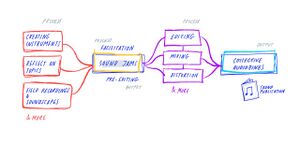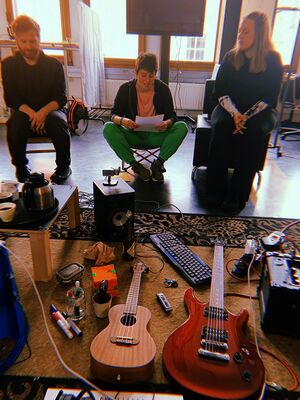Sound jams research: Difference between revisions
| Line 60: | Line 60: | ||
==== recordings & mix ==== | ==== recordings & mix ==== | ||
[https://hub.xpub.nl/soupboat/~alnik/xpub2/jam-recordings/2022-10-10-MMs/m&ms-jam-diffractive-listening-edit1.mp3 diffractive mixing - edit 1.0] | ⟿ [https://hub.xpub.nl/soupboat/~alnik/xpub2/jam-recordings/2022-10-10-MMs/m&ms-jam-diffractive-listening-edit1.mp3 diffractive mixing - edit 1.0] | ||
==== wip ==== | ==== wip ==== | ||
▶ [https://pad.xpub.nl/p/mitsal-xpub2-research-mms working pad] - preparation of the session | ▶ [https://pad.xpub.nl/p/mitsal-xpub2-research-mms working pad] - preparation of the session | ||
Revision as of 14:16, 11 October 2022
about
This page is about the collective research on sound publications, audiozines and sound jams by mits🤖 & ☾ Ål Nik ☾.
Our research has started with facilitation of sound jams and it explores various directions simultaneously. We have brainstormed about:
# ways to create a collective sound publication [sound jams] // october-november 2022
-we will make series of facilitated jams in order to explore various ways to create sound publications and audiozines in group
-we understand jams as collective moments of listening and responding - we create improvised sound pieces together no matter if we have musical training or not
-we will explore various topics through introducing reads and different ways to conduct a jam session
-we will try out collectively several aspects of our individual research
-we will ask for consent for recording the sessions and for editing them later
# ways to collect sound // tba
-we are interested in exploring soundscapes
-field recordings will also happen during facilitated jams - some jams will take place outside and will explore soundscapes
-create instruments and sounds (also with pure data, interfaces for generating recordings)
# ways to edit sound pieces and create audiozines [mixing and editing] // tba
-we would like to explore ways to mix and edit sound
-we are interested in finding out why we edit in a particular way
-we are going to research the theoretical background of mixing and editing, too
sound jams
_01 M&Ms
// 10-10-2022
participants
mitsa, jian, kamo, miriam, alex, emma, manetta, gersande, chae, joseph [in order to the clock]
feedback & reflections
-overall: it was nice; a well-facilitated jam
-the clock structure - helps to listen to the others and move around organically; frustrating when you want to play with someone or some instrument specifically
-instruments shape the experience - some instruments (and/or for some participants) require more focus and it makes it difficult to focus on listening & responding
-improvised instructions in the middle are confusing when the sign language is not introduced ahead / to be given really clearly
-everyone playing at the same time is confusing - climbing up is better (create a slow progression)
-different instruments - different volume and space-taking - great for learning to listen and pay attention
-maybe try giving instruments to people that they never used before - to put everyone at a similar "start"
-visual score will help people without musical training or who are more visual
-warming up can include a moment to explore the instruments
-it will be better if the 5th person starts before the 1st stops
-keep doing the jams with having some of the same participants over and over again - for being able to experiment more and try different things
-don't be afraid to ask people to come to jams when you want to try out new things
learnings
-if we improvise instructions or change the rules during the jam - make sure everyone understands clearly the change
-progression works well for the clock structure - we can create a score that progresses with each round
-always have two recorders working
recordings & mix
⟿ diffractive mixing - edit 1.0
wip
▶ working pad - preparation of the session


